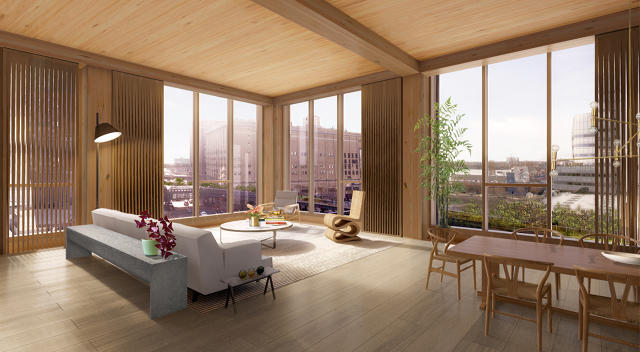The First All-Wood High-Rise Buildings Are Going Up In The United States
In New York and Portland, two high-rise buildings will be made not from concrete or metal, but a throwback material: good old trees.
It seems as if New York City is always under construction. Every few blocks, steel frames and concrete beams are formed and stacked high in the air. Now a new 10-story building in Manhattan is planned that will be unlike any other in the U.S: It will be made almost entirely from wood.
Wood is an old building material that has been getting a new life in taller buildings over the last five years. Around the world, 17 wood buildings have been built that are between seven and 15 stories tall—many of them in Europe. A record-high 35-story wood building is in the planning stages in Paris. But the U.S. has been slow to start exploring the recent advancements in wood materials that have made these taller buildings possible. None exist here today.
Last year, in partnership with the lumber industry, the Department of Agriculture announced a $3 million prize intended to spur tall wood building designs in the U.S.. Today, it announced two winners that will split the money: The 10-story residential condo, slated for Manhattan’s Chelsea neighborhood, and a 12-story retail, office, and apartment building in Portland, Oregon.

In the interest of creating rural jobs, the Agriculture Department has a stake in promoting wood, as does the lumber industry—which has struggled since the housing crisis. But there can also be major sustainability benefits to wood as a building material.
“As cities are growing, they’re using a tremendous amount of concrete and steel, and the problem with that is that concrete and steel have a very big carbon footprint,” says Vishaan Chakrabarti, a principal at SHoP Architects, which designed the New York City project.
In manufacturing and construction, wood generally has a lower carbon footprint than other common building materials. In addition, the wood itself stores extra carbon (at least in the U.S., where logging regulations are strict and trees are farmed, not deforested). Diseased wood from western U.S. forests afflicted by pests such as mountain pine beetle can even be used in newer advanced wood products. Normally, this dead wood adds to the fire risk when left in place.
Building taller and larger structures with wood has only become possible in recent years, as the industry has created denser, engineered wood products that are more flexible, stronger, and more fire resistant than the traditional two-by-four beam. But current U.S. building codes generally allow wood buildings to be only six stories or less, and regulators and designers are naturally wary of trying new methods. The goal of the competition is to demonstrate it can be done.
“If you think about traveling through New York City and seeing buildings being made from steel and concrete, and all of the sudden in the middle of all this, you see this new wood constructed building—it’s going to catch your attention. I think it’s going to create some real interest,” says U.S. Secretary of Agriculture Tom Vilsack.
There are other benefits to using wood. Major building parts are prefabricated, so disruptive construction time can be up to half that of a typical building (construction noise and traffic disruption is a huge nuisance in many cities). They are also more energy efficient because of tighter fittings and can cost less.
The structural elements of the New York City project will all be made from wood, with the exception of concrete used for the floors (but not for the ceilings). Wood will also comprise the walls and many interior elements as well. The building will have to undergo a special review by the New York City Department of Buildings, but the architects say it will meet all existing building codes. The city has issued a general letter of support for the project, and if the review goes well, construction could go forward next year.
In Oregon, Vilsack says the prototype project will help demonstrate potential demand for the first U.S. manufacturing facility for cross laminated timber, a stronger wood material that is required for these taller buildings. The Department estimates that if “next-generation wood products” can penetrate 15% of the non-residential North American market, it could create up to 85,000 jobs in struggling rural communities.
“There’s really an unlimited opportunity here for creativity and imagination to redefine cityscapes and to redefine the role that wood can play,” says Vilsack.
Fast Company , Read Full Story
(62)


